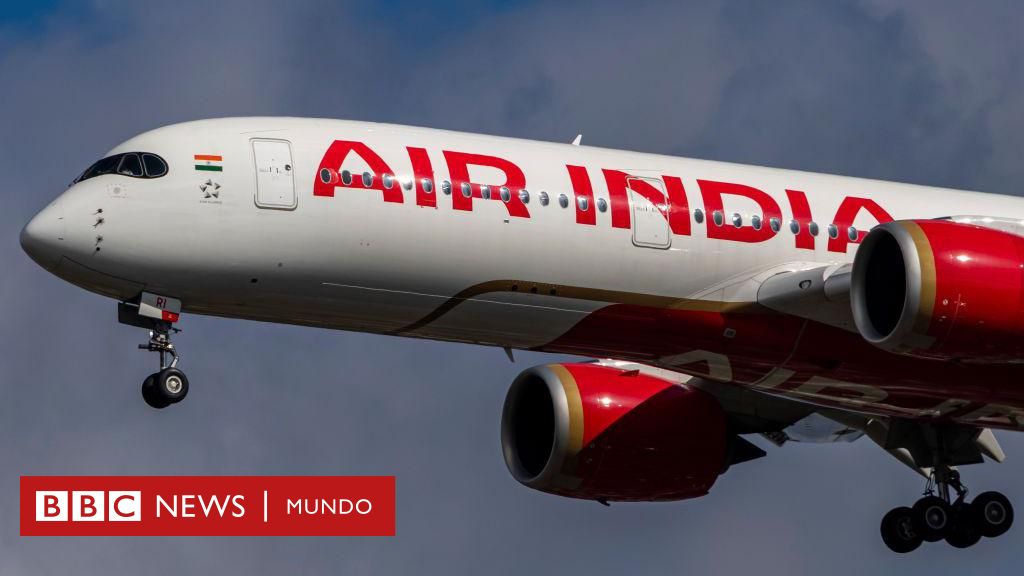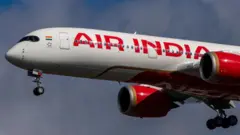

Image source, Getty Images
- Author, Soutik Biswas, Matt Murphy y Joshua Cheetham
- Author's title, BBC News*
Researchers from India, the United States and the United Kingdom will try in the next few days to determine what caused the Boeing 787-8 Dreamline to crash shortly after takeoff, only 1.5 km from the track of the Sardar Vallabhbhai Patel International Airport.
What happened exactly to the AI171 flight between Ahmedabad and London Gatwick this Thursday will only reveal a detailed investigation, but the moments after takeoff are usually the most difficult in aviation.
In Thursday's catastrophe 241 people died on board and more victims registered on land.
It is the first time that a 787-8 Dreamliner plane suffers an accident of this nature since it entered commercial service in 2011.
The BBC has spoken with aviation experts, as well as with headquarters in India-some of which they spoke on condition of anonymity-that regularly fly the 787-8 to understand what factors could have caused the plane to crash against residential buildings in the heart of Ahmedabad at the few moments of takeoff.
1. It was hard for him to gain height
The 787-8 Dreamliner was piloted by Captain Sumeet Sabharwal and his co-pilot Clive Kundar. The two had a great experience, with more than 9,000 flight hours combined; Sabharwal had accumulated more than 22 years of experience as a pilot of commercial airlines.
The plane transported 242 people while rolling along the track of Ahmedabad International Airport Thursday afternoon. The plane took off at 13.39 local time (08.09 GMT), according to the Air India company.
The Indian Minister of the Interior, Amit Shah, declared that the plane transported 100 tons of fuel – practically a complete load – while leaving Ahmedabad.
Almost immediately after takeoff, the cabin issued a relief signal, according to the Indian aviation regulator. After that, the aircraft did not respond again.
It is not clear what caused the relief call, but the only flight survivor has declared to the Indian media that he heard a strong rumble when the plane was hard for him to gain height.

Image source, Getty Images
Some images analyzed by BBC Verify show the plane flying to low height on what appears to be a residential neighborhood.
The latest transmitted data show that the plane reached a height of 190 meters. It proceeds to descend and is hidden by trees and buildings, before a great explosion appears on the horizon.
“He wouldn't have reacted time if he lost both engines,” said a pilot.
CCTV images seen by BBC Verify showed that the plane was in the air for 30 seconds.
The plane crashed into a residential area, with images that showed severely damaged housing blocks in a densely constructed area that included hospitals and official buildings.
2. It is speculated with a “very rare” double engine failure
From the videos of the short flight of the plane it is almost impossible to definitely determine the cause of the catastrophe.
In the next few days a complex investigation will begin, including the revision of the black box of the plane – which records the flight data – and the examination of the remains.
But the videos that have appeared show the plane struggling to take off from the ground, apparently due to lack of thrust or power.
Some experts have speculated with the possibility of a double engine failure, something extremely rare.
Doubts have been raised about whether the plane had its Ram Air Turbine (Rat) turbine, an emergency reserve turbine that comes into operation when main engines cannot generate energy for essential systems.

Image source, Getty Images
The failures of two engines are almost unheard of. The most notable example was the “miracle in the Hudson” of 2009, when an Airbus A320 of US Airways lost the two engines due to the impact against birds moments after taking off from the New York Laguardia airport, but planned until it was safe.
A high -level pilot declared to the BBC that the two -engines failure could also be due to contamination or fuel obstruction.
Aircraft engines are based on a precise fuel measurement system, and if it is obstructed, it can cause the lack of fuel and engine stop.
Marco Chan, an expilot, told BBC Verify that, judging by the available images, there is no evidence to suggest a double motor failure.
Mohan Ranganathan, an aviation expert, told the BBC that a double engine failure would be “a very, very rare incident.”
The GE Aerospace engines stated that he was going to send a team to India to help in the investigation, while Boeing said he offered all his support to the airline.
3. Shock with birds
Another possibility raised by some experts in India is the clash with birds, which can be extremely dangerous for aircraft.
In severe cases, engines can lose power if they aspire to a bird, as happened in Jeju's aerial catastrophe, in South Korea, in which 179 people died last year.
Experts and pilots familiar with Ahmedabad airport have declared BBC that it is “famous for birds.”
“They are always there,” says Ranganathan, echoing the statements to the BBC of at least three Indian pilots who have flown inside and outside the airport.

Image source, Getty Images
The state of Gujarat, where Ahmedabad is located, registered 462 incidents of bird crashes in five years, most of them at the Ahmedabad airport, according to data from the Ministry of Civil Aviation presented in Parliament in December 2023.
A report of Times of India September 2023 cited data from the Airport Authority that indicated 38 clashes with birds in the 2022-2023 period in Ahmedabad, an increase of 35% compared to the previous 12 months.
In a 2009 case, a sea flock was ingested at 2,700 feet, more than four times more than Air India flight. In this case, the Indian pilots had neither altitude nor time to maneuver.
However, an experienced pilot said that the impact of a bird is not usually catastrophic “unless it affects both engines.”
4. Could they have contributed the plane ailerons?
Three experts who talked to BBC Verify suggested that the catastrophe could happen because the plane alerons were not extended during takeoff, although other pilots and analysts have questioned it.
The spoilers play a vital role during takeoff, since they help the aircraft to generate maximum support at low speeds.

If they are not well extended, a cap loaded -with passengers, heavy fuel for a long distance flight and facing heat – will have difficulty taking off.
In Ahmedabad, where the temperatures was touched by 40 ° C on Thursday, the finest air – by the change of density that causes heat – would have demanded a greater configuration of the alerons and a greater thrust of the engine, according to a pilot to the BBC. Under such conditions, even a small configuration error can have catastrophic consequences.
CCTV images that appeared on Thursday afternoon showed how the plane took off from Ahmedabad, struggled to reach altitude and descended slowly before crashing.
According to one of the pilots with whom the BBC spoke, if the plane took off with the welded ailerons, the 787 take -off configuration alert system would have warned the crew that the configuration was not sure.
The Expileot Chan declared BBC Verify that the images that have appeared so far are too distorted to determine with certainty if the spoilers were extended, but said that a error of this type would be “very unusual.”
“The alerons are adjusted by the pilots themselves, before takeoff, and there are several checklists and procedures to verify the adjustment,” Chan said. “That would point to a possible human error if they do not adjust correctly.”
*Additional information from Jake Horton.
Subscribe here To our new newsletter to receive every Friday a selection of our best content of the week.
And remember that you can receive notifications in our app. Download the latest version and act.